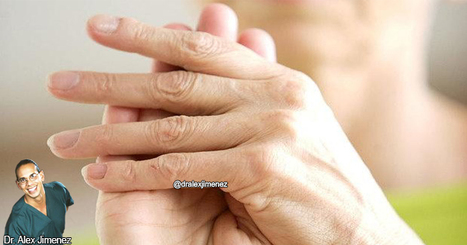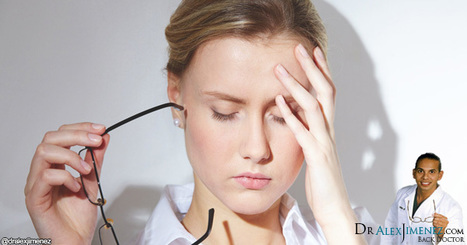 Your new post is loading...
 Your new post is loading...
If you’re a person with a sedentary lifestyle, exercising more will bring many benefits for improving your health. Engaging in physical activity helps burn calories, preventing excess weight gain and supports weight loss. Exercise also stimulates several chemical reactions in the brain that can boost your mood as well as relieve stress, making you feel happier and more relaxed. Following a balanced nutrition is also a great way to improve your health. Adding more quality food into your diet, such as fresh fruits and vegetables, as well as reducing the amount of processed foods you consume will benefit your overall wellness. A proper diet together with an exercise routine can help maintain a healthy weight. Eating vitamin and mineral rich foods while avoiding fats, sugars, and salts can help avoid heart disease and hypertension from developing. Hydration, along with a good diet and physical activity, is also very important for your health. Drinking the appropriate amount of water necessary for each individual has many benefits on the body. Most importantly, the body requires water for the majority of its functions and without proper hydration, the body may not function to its fullest capacity. And last but not least, make sure you’re getting good quality rest. Sleeping should be a top priority when it comes to achieving your optimal health, fitness, and wellness goals as it has many benefits for the body. Getting proper rest improves your mood and can also assist in weight loss.
Chiropractic care is not commonly utilized as a treatment option for stress but, many individuals who receive chiropractic treatment can often feel relief from stress due to a variety of reasons. Stress not only affects the human mind but the physical body as well. When a person has been under a lot of stress, the nervous system can become irritated and directly affect the muscular system, causing a build up of tension and tightness. We are constantly being exposed to environmental stressors. Other stressors can derive within our own body and mind. Although some levels of stress are normal and necessary in order for individuals to function efficiently and effectively under certain pressure, elevated and constant amounts of stress can be debilitating. Using simple techniques to both recognize and regulate stress as well as developing healthy eating habits and exercise routines can tremendously help maintain healthy levels of stress in your life. Through chiropractic care, a chiropractor can identify areas of the spine that lack proper functioning and locate any irritated nerves. Using spinal adjustments and manual manipulation, the original mobility of the spine can be corrected to remove the pressure on the nerves. When the additional tension being placed on the spine is reduced, many individuals feel great relief and relaxation.
A common reason runners end up hurt is their bodies had something “out of whack” in the first place. Since chiropractors take the wellness of the body as a whole into consideration, they often work with runners to minimize the chance of re-injuring themselves or suffering a different injury. By making certain an individual’s body is in alignment and functioning properly, a chiropractor can help the runner feel comfortable moving back into the routine of running. Running is a great form of exercise and stress relief, and many people run for years without incident. However, it’s vital to take steps up front to minimize the chances of getting hurt, including choosing proper shoes, stretching beforehand, and avoiding overexertion. If, however, you feel a twist, pop, or crack as you are out for your morning run or finishing your half marathon, know there are chiropractic treatment options available to you that will decrease pain, healing time, and the risk of re-injury.
Depression approximately affects more than 3 million people in the United States alone. A majority of people resolve to taking antidepressants in an attempt to relieve their symptoms of depression but using medication doesn’t have to be your first option for treatment. You can reduce your depression, and improve your mood and overall mental health by using the following natural antidepressants. Exercise is believed to be the number one, but often underused, natural antidepressant effective towards treating mild to moderate depression. When you exercise, the body releases chemicals known as endorphins which collaborate with receptors in the brain to reduce the perception of pain. Endorphins trigger a positive feeling in the body, helping to reduce stress, boost self-esteem, and avert anxiety and feelings of depression. Sunlight exposure is also a great natural antidepressant. An exposure to sunlight triggers the brain’s release of a hormone known as serotonin. If there is not enough exposure to sunlight, an individual’s levels of serotonin in their body can drop significantly. The low levels of serotonin can often be associated with an increased risk for people to develop depression. Getting anywhere from 5 to 15 minutes of indirect sunlight, 2 to 3 times a week can be enough to feel the positive benefits of the sun on your mood. Sugar can also largely aggravate depression. The consumption of sugar causes tremendous highs and lows in the body’s glucose metabolism. Also, the body uses vitamin B to process sugar. Vitamin B helps convert food into energy as well as regulate the nervous system. If you use up your vitamin B processing sugars, there won’t be much left to help regulate your mood.
Back injuries and its associated pain, discomfort, and other symptoms are part of an undesirable situation which unfortunately many people commonly experience at one point in their lifetimes. Chiropractic care can help treat many injuries or conditions that could be causing your back pain but before seeking medical attention, even before your injury, preventing damage to your body is the best option for living without back complications and all its undesirable symptoms. First of all, for individuals who enjoy running and/or other running sports, preventing back injuries doesn’t require them to stop running. As with many other types of physical activity, running is a great way of maintaining physical fitness. The constant and repetitive motion of the feet commonly causes the cartilage of the joints and other structures to wear out, leading to irritation, and other problems. To prevent injury from running, simply remember to take plenty of rest in between runs as well as properly stretching and warming up the body before starting a long run. Cross training is another preventive measure that can be used for a majority of physical activities or sports. Cross training refers to the participation in two or more sports of different types of fitness workouts, such as cycling or swimming, to supplement another physical activity or sport, such as running. A proper fitness training requires cardio, strength, and flexibility exercises to evenly condition the body as well as balance the workout load as to not damage or injure yourself. And last, including several low or no impact activities into your cardio and strength training, such as yoga or pilates, can help keep you strong and injury free.
Shoulder pain can be caused by numerous injuries which directly affect the surrounding structures of the shoulder joint and/or conditions which may originate from other regions of the body, such as the spine. There are several types of treatments to help an individual’s shoulder symptoms accordingly, although each different, these can all achieve shoulder pain relief. Before starting treatment for shoulder pain, despite the type of injury or condition, correcting the body’s ability to stabilize the affected individual’s shoulder blades can help reduce symptoms. Shoulder blade pinches are an effective and simple exercise that can help stabilize the shoulders. First, you have to bring your shoulder blades together and down, making sure you don’t move your arms and then, you hold that position for about 5 seconds. Approximately 30 shoulder blade pinches can help improve the stability of the shoulders and relieve some of the symptoms. Another treatment option for shoulder pain that can also be used effectively for improving shoulder injury symptoms is elastic therapeutic tape. The therapeutic tape is an elastic, cotton strip with an acrylic adhesive that usually comes in a variety of colors. It’s recommended to seek a medical professional who specializes in the accurate use and placement of elastic therapeutic tape. If properly applies, the elastic therapeutic taping method can greatly benefit an individual’s shoulder injury or condition and help alleviate shoulder pain and other symptoms. Finally, chiropractic treatment can be an effective treatment option for many types of shoulder injuries and conditions as well as help keep the symptoms away for good. According to the individual’s symptoms, shoulder adjustments and manual manipulations can be performed by a chiropractor to slowly shift it in its proper placement. Additionally, the chiropractor can also adjust the neck and upper back to further help relieve shoulder pain and discomfort.
Handpicked Top 3 Chiropractors in El Paso, TX. We check customer reviews, history, complaints, ratings, satisfaction, trust, cost and their excellence.
Boron is one of the main minerals used in the bone building process of the body which directly acts as an activator. Boron helps convert vitamin D into its active state by initiating estrogen production. The estrogen then improves the absorption of calcium. This mineral also helps ensure the metabolism within the bone can function properly. In fact, because of its role in the body, Boron can actually assist in preventing arthritis and tooth decay. The body depends on Boron to perform a large majority of its functions and when there is a Boron deficiency in the body, the parathyroid glands, small endocrine glands in the neck of humans, become overactive, causing the glands to release too much of the parathyroid hormone. As a result, the level of calcium in the blood increases as it’s released from the bones, joints, and teeth, into the blood stream. Several resulting symptoms of Boron deficiencies include, arthritis, brittle bones, carpal tunnel syndrome, degenerative joint disease, hormonal imbalances, loss of libido, memory loss, muscle pain, osteoporosis, receding gums, and weak joint cartilage. Bone analysis have previously shown that arthritis joints and nearby bones contain only half the Boron content of healthy joints. Boron supplements can help reduce the daily loss of calcium by nearly 50%. Because this calcium is mainly withdrawn from the bones and teeth, Boron deficiencies are considered to be the most important factors in causing arthritis, osteoporosis, and tooth decay today. Boron supplements are actually considered to be an effective treatment for up to 95% in the relief of arthritis, provided the joint has not completely deteriorated.
About 80% of golf athletes experience re-occurring back pain. When the swings a golf professional takes during a round begin to add up, including all shots and all practice swings, one can begin to notice that the movements used during golf involve a lot of one directional repetition. With golfers, this often tends to cause individuals to be flexible on one direction and very stiff in the other. There are a few simple steps to take to avoid developing back problems while doing the sport you love. Foremost, its essential to warm up the body before golfing. This doesn’t necessarily mean stretching. Many people will often rush to the course after work, while hoping not to be late, and they run up to the field and begin taking swings. Next time you golf, start with spinal twists. First, spread your feet shoulder width apart, interlace your fingers, point your hips forward and rotate your shoulders independently of your hips. This simple exercise will help loosen up your spine. Second, try several walking lunges. The walking lunges will help loosen up the hips and warm up the muscles. Finally, doing some standing crunches can help activate the abs. While standing, grip your finger tips loosely behind your head and then crunch each elbow to the opposite hip. About 15 of these should be enough to warm up your core. Before attempting any of the above exercises, be sure to consult a specialist in order to determine an appropriate exercise and stretching routine in case of a previous injury or underlying condition. It’s crucial to prevent any further injuries in order for you to continue participating in the sports and physical activities you enjoy.
Back pain is one of the most common debilitating symptoms affecting a majority of individuals. A greater number of people though will often overlook the possible source of their pain and continue throughout their regular lifestyles, postponing medical attention when their symptoms lessen. But, what happens when one day, you bend over to pick up a small object and you can’t stand up? Back pain or spasms are usually a sign of spine complications that, if left untreated, can ultimately alter your lifestyle. Back spams are a sudden and involuntary contraction, or tightening of a muscle in the back as a result of strain, overuse, weakness, or muscle pain relating to an injury or condition. While the most appropriate action would be to seek immediate medical attention, back spams can be temporarily relieved using ice therapy. Also, after experiencing a back spasm, make sure to keep moving. With back pain or other symptoms, an individual’s natural response is to lay down and avoid movement but, in fact, resting and immobilizing the body after a back spasm will only cause the surrounding muscles to spasm and tighten further. Then, it’s time to seek medical attention. A chiropractor can diagnose the underlying cause of your back pain and follow with an appropriate treatment procedure depending on the individual’s level of injury or grade of condition. While the back spasm that brought you to seek medical attention came on suddenly, the problem that caused your symptoms generally developed gradually over time. Receiving chiropractic treatment for any spine complications is crucial in order to avoid a back issue that could drastically affect your quality of life.
After being diagnosed with carpal tunnel syndrome, it’s associated symptoms are often a cause for anyone to seek immediate medical attention. Carpal tunnel syndrome is a condition caused when the median nerve, found within the carpal tunnel of the wrist, is compressed as a result of irritation, inflammation, or other underlying condition, and is characterized by symptoms of numbness and tingling sensations, weakness, and pain in part of the hand or certain fingers. Although carpal tunnel syndrome is well-known as a complication of the wrist, spinal chiropractic adjustments can help with the condition. In fact, many cases of carpal tunnel syndrome can relate to complications on the cervical spine or neck. The median nerve or other nerves that travel through the hands may be impinged at the wrist but those same nerves originate from the neck. Any spinal complication causing a subluxation or misalignment of the spine, restricted mobility in the vertebra, or direct trauma from an injury to the spine, can interfere with the nerve impulse transmissions that trail down the arms and into the hands. A neck issue as the origin of carpal tunnel syndrome can commonly be determined when both hands are affected by the condition and its symptoms. A chiropractor can help diagnose the source of an individual’s carpal tunnel syndrome. Chiropractic adjustments to the spine will gradually assist to re-align the spine and slowly release compression of the nerves that could be occurring on the spine.
Chronic stress, is a response to an emotional pressure that occurs for an extended period of time which an individual is unable to control. On a daily basis, people are constantly exposed to situations that could trigger a stress response on their body, whether it’s from a long, hard day at work behind a desk or an upcoming test. For some individuals, the stress on their body becomes overly constant and eventually, they begin to develop chronic pain symptoms. First of all, the position of the body while sitting at a computer is usually that of an incorrect posture. By spending long periods of time in front of a computer screen, a person will gradually start to bend forward from the natural sitting position, creating strain throughout the spine and its surrounding muscles. Also, the incorrect seated position causes the hip flexors to chronically contract, causing low back pain. Any additional stress after this point can often add tension to the shoulders, further straining the muscles around the upper back and neck. Through time, the body recreates this cycle over and over again, leading to chronic pain. Chiropractic care can also help relieve chronic pain caused by chronic stress. Chiropractic adjustments can help break the pain cycle by realigning the spine to help improve posture, decrease the tension on the muscles, and help prevent chronic stress from accumulating in the body.
Headaches, identified as pain or discomfort in the head, are the most frequent form of pain experienced by the general population. While the majority of headaches are relatively simple to reduce or eliminate, many people can experience constant head pain without knowing the true cause of their symptoms. As an individual suffering from chronic headaches, it’s important to foremost determine the origin of the headache. There are many injuries or conditions that could cause chronic headaches but, these are most commonly due to spine-related problems. The most common cause of headaches can relate to neck complications. From spending excessive time looking down at a laptop, desktop, iPad, and even from constant texting, an incorrect posture for extended periods of time can begin to place pressure on the neck and upper back leading to problems that could cause headaches. The majority of these type of headaches occurs as a result of tightness between the shoulder blades, which in turn causes the muscles on the top of the shoulders to also tighten and radiate pain into the head. If the source of the headaches is related to a complication of the cervical spine or other region of the spine and muscles, chiropractic care, such as chiropractic adjustments, manual manipulation, and physical therapy, can be a good treatment option. Also, a chiropractor may often follow up chiropractic treatment with a series of exercises in order to improve posture as well as offering advice for future lifestyle improvements to avoid further complications.
|
Back pain is among the most common physical complication affecting a majority of educators. Whether you’re a preschool teacher or a college professor, injuries or conditions that affect your natural well-being can be prevented or reduced, principally by improving posture and then following through with a variety of health tips to avoid and improve further complications. Teachers frequently stand for an extended period of time for lectures which can place an additional amount of pressure on the lower back, pelvis, and thighs, often leading to the development of an incorrect posture. Also, prolonged standing on hard surfaces can cause sore feet, swollen legs, and aggravate back pain. Furthermore, sitting down for long periods of time, stooping over children at their desks, and even carrying small children, heavy objects, or paperwork, could cause damage or injury to the muscles and tissues surrounding the spine. Stress can be a huge factor towards a teacher developing mental and physical complications and symptoms, including back pain. Increased levels of stress in teachers can prevent them from getting a good night’s rest, resulting in insomnia that can eventually lead to fatigue due to lack of sleep, triggering physical complications. Chiropractic treatment can be utilized by teachers to both treat and prevent spinal complications as well as help decrease levels of stress. Chiropractic care is not frequently used to directly treat stress but a careful realignment of the spine can provide relief and relaxation from many complications and symptoms that can help reduce stress. A chiropractor will also determine the source of the back pain and follow up with a specialized treatment plan to gradually restore an individual’s health. Chiropractic treatment can include spinal adjustments, manual manipulation, and several stretches and exercises to speed up the healing process and promote wellness.
The piriformis muscle, a small muscle located deep in the buttocks, plays the important role of rotating the legs outwards. Piriformis syndrome is a painful condition that occurs when the piriformis muscle becomes too tight, compressing the sciatic nerve that runs through the buttocks. Characterized by symptoms of pain, tenderness, and occasionally, numbness around the area of the buttocks, piriformis syndrome symptoms may also expand down an individual’s leg including the calf. Piriformis syndrome can be caused by several reasons but there are two frequently notable causes for the condition. First, sitting for extended periods of time can cause the piriformis muscle to tighten. Second, an accident resulting in direct injury such as a fall or a sports-related injury can damage the piriformis muscle. Trauma to this muscle in the buttocks can cause the surrounding tissue to become inflamed and swollen, leading to compression and possible irritation of the sciatic nerve. Muscle spasms can also cause piriformis syndrome. Usually starting as a muscle strain, a muscle spasm can occur abruptly and cause pain. However, the source of muscle spasms can frequently be unknown. Regardless of the initial cause, being aware of your treatment options for piriformis syndrome is essential towards alleviating the painful symptoms and healing the condition.
Chiropractic care focuses on treating spinal injuries or conditions, as well as other musculoskeletal traumas or disorders, through the use of spinal adjustments, manual manipulation, and occasionally, a set of recommended exercises and stretches. Chiropractic treatment can benefit people with a variety of complications as well as children. Spine Health is essential for all ages. Infants, for example, can often experience trauma on the head and neck during birth through the normal procedures of labor. Chiropractic adjustments in a growing child can help align their spine in the case of early subluxations, or spinal misalignments. Properly aligning a child’s developing spine can help prevent the development of various ailments as well as maintain a normal formation of the bones in the spine. Regular adjustments can also be especially useful for both younger and older children because of the increased number of falls and/or accidents that may occur through their normal physical activities on the playground or in the sports arena. Chiropractic care can be especially useful for correcting abnormal spinal development disorders such as scoliosis in children. Through early diagnosis and treatment of a child with scoliosis, a chiropractor can use regular spinal adjustments along with an appropriate follow up of exercises to properly align the spine of a child and allow the spine to develop appropriately, improving their overall spinal health in the future. Chiropractors are also specifically trained to implement adjustments especially designed for babies and young adults. Chiropractic care provides a safe and natural way that is effective towards children to prevent and treat many different injuries and conditions.
For an individual with neck pain, the hardships that come with a deep sleep are not unusual, however, choosing a proper pillow can help ease the symptoms of neck pain. The only requirement is, taking careful considerations of your own sleeping habits to purchase a pillow that will benefit your overall health in the long run. There are numerous varieties of pillows to choose from but beforehand, you must first determine the primary position you sleep in. Pillows come in a variety of shapes, sizes, and firmness, and, depending on your sleeping position, some pillows can support the head and neck more comfortably than others. When shopping for a new pillow, consider the following tips and avoid settling for an improper pillow choice. First, before selecting a new pillow, make sure to consult your chiropractor for suggestions. Chiropractors understand the cause of neck pain better than many and they may give you valuable information and recommendations on which type of pillow would be most beneficial for your sleeping posture and source of neck symptoms. Then, consider doing some research in terms of a pillow’s filling before purchasing one. Pillows are filled with a variety of material which is also important when considering which type of pillow will be the best choice for you. Also, it’s important to consider the size of the pillow. Pillows typically range between 4 to 6 inches in height in order to help relieve pressure points around the neck and shoulders. Pillows which tend to be thicker or flatter then the average height are most often improper choices for the majority of people. An individuals size in relation to their pillow should also be considered. The function of a pillow is to provide comfort and support as well as hold the neck in a neutral position while sleeping. If your current pillow is not doing this for you, it could be one source for your neck pain.
Stress is the body’s response to any kind of demand or threat that disturbs a person’s physical and/or mental balance. When you feel endangered, the nervous system reacts by releasing a large quantity of stress hormones including adrenaline and cortisol which prepare the body for emergency action. Because of this, an individual’s heart rate increases, muscles tighten, blood pressure rises, breath quickens, and the senses ultimately become sharper. Healthy levels of stress can help us defend ourselves at a time of danger and boost our reaction time to avoid danger when needed but when stress accumulates and reaches levels beyond the normal comfort zone, stress can stop being helpful and begin to cause major complications to both an individual’s mind and body. Unhealthy levels of stress commonly cause pain and aches of various types, digestive problems, sleep problems, weight problems, depression, and in more serious cases, heart disease, auto-immune diseases, and skin conditions such as eczema. Eliminating stress entirely is the best solution for avoiding these types of complications but while the process of doing so can occur gradually and take time, reducing the amounts of stress in the body can help decrease its effects on the body. First, closing your eyes, take 10 deep breaths while focusing on inhaling and exhaling. This process can help slowly relax the body. Then, when there’s a high concentration of stress, it’s essential to avoid consuming sugars altogether as it can create mood swings. Then, it’s often recommended to take part in some form of physical activity every day. From taking a walk to participating in an exercise class, staying active can also help reduce the levels of stress in your body. And finally, take some time for yourself to stop using your media devices and social media to enjoy some quiet time with your loved ones, focusing on what you’ve achieved and setting up new goals for the future.
Individuals with a previous knee injury often describe feeling continuous symptoms for an extended period of time after the original trauma. Fortunately, the majority of knee injuries usually involve minor damage and injury to the ligaments of the knee. Most knee complications that chiropractic doctors and other medical specialists diagnose are often caused by stiffness and soreness that, when left untreated, can eventually lead to further complications on the knee and its surrounding tissues. Warming up the body before any workout is important to prevent injuries. Before starting a physical activity routine, stretching or simple exercises, such as deep knee bends or knee rolls, help warm up the knees by getting the fluid within them moving and lubricating the cartilage. After the workout, it’s also important to stretch out the knees especially by stretching the quads and IT band. The quads are made up of 4 sections of muscles in the front of the leg and when all these muscles, along with the IT band, are too tight, the knee cap can be unevenly pulled up and down the leg, commonly resulting in injuries such as patellar maltracking syndrome or runner’s knee. Chiropractic treatment can also help eliminate pre and post-workout knee soreness. A chiropractor can diagnose the root cause of an individual’s knee pain and symptoms in order to determine the best treatment options for the injury or possible condition. Through chiropractic adjustments and manual manipulation, the chiropractor may help adjust spine misalignments that could be causing knee pain as well.
If you’re constantly blaming your bad mood or scattered mind on a bad night’s sleep, it may be time to rethink. Research suggests the amount of sleep you think you got can be more important than actual shut-eye. A 2014 study on “placebo sleep” found that when people were told they’d had a good night’s slee
. With chiropractic adjustments, a chiropractor will work to gradually correct any spinal misalignments that could be causing the headaches. While many people might already have the knowledge to seek chiropractic treatment for these type of symptoms, many of these same people often don’t know the source of their headaches. Spending extended periods of time in front of the computer is a common cause for headaches. After about an hour of sitting at your computer, people often start to hunch over and slump their heads forward towards the screen, where the shoulders will begin to round. In time, the body begins to feel comfortable in this position rather than a normal, healthy posture. Also, too much stress and tension on the neck and shoulders is another common cause for headaches. Each individual carries their stress in different areas of the body. While for some people, tension can build up on the lower back, the majority of people build tension on their neck and shoulders. Finally, clenching the teeth at night and TMJ, or temporomandibular joint disorders, are known as one of the biggest causes for headaches. Often though, people don’t realize that the jaw can be adjusted just like other parts of the body. There are many other causes for headaches that may also be treated with chiropractic adjustments but these are some of the most frequent causes that could be causing your head pain. With consistent chiropractic treatment, your headache symptoms could be greatly reduced and relieved.
With summer right around the corner, many people have started planning for their annual summer vacation trip but, along with the rest of the preparations, it’s important to keep in mind how traveling can often be associated with symptoms of back and neck pain. Traveling through airplane, or even a bus, can be both mentally and physically exhausting and those who’ve traveled before have surely experienced some form of physical pain or discomfort. In order to compensate for the larger quantity of people using airplanes or buses, the leg room has shrunk and the majority of seats have had the cushion removed to free up more space. Typically, the cushion of a seat serves to absorb shock before it transmits into the spine from the molded plastic seat but, with its absence, the spine is forced into an uncomfortable posture for extended periods of time that most frequently cause back or neck pain. Furthermore, choosing the aisle seats can provide more room to stretch out. These will also allow you to get up more frequently to stretch out and walk around without disturbing the sleeping person sitting next to you. When taking a long flight on an airplane or drive on a bus, the C-shaped neck pillows available on the market can be a valuable purchase. Before the long trip, its important to take precautions when lifting or yanking luggage out of a vehicle as well as being careful when constantly switching it from side to side to prevent pain and injury. Packing light while on a trip is a good way to ultimately decrease the chance of a luggage injury.
Although colds and flu are most frequent around the winter months, maintaining a healthy immune system throughout the year can be beneficial for keeping the body healthy overall. From medication to supplements, there’s widespread knowledge on how to achieve an immunity boost. However, improving and maintaining a healthy immune system can also be accomplished through natural alternatives. First of all, plenty of rest daily is important for improving and maintaining a healthy immune system. Research shows that individuals who consistently sleep between 7-8 hours, have stronger immune systems and are less likely to get sick. Then, in order to improve and maintain a healthy immune system, its important to eat plenty of fruits and vegetables instead of consuming sugary, processed snacks.Exercise is also an essential part of maintaining overall health, especially when improving immunity. Keeping hydrated allow the structures in the body to function at their full capacity but having enough water in your system also helps filter the waste products out of your body. Finally, regular chiropractic adjustment can help both improve and maintain a healthy immune system. By receiving regular chiropractic care, a chiropractor can help ensure the body is functioning to its full capacity.
Numbness in any portion of the hand or in specific fingers, followed by a tingling sensation and sharp pain traveling through the hands can occur as a result of various underlying conditions. Many people report symptoms suggesting the development of carpal tunnel syndrome but, although diagnosis might indicate the cause for the condition, sometimes a diagnosis could point to the incorrect root of the problem. The median nerve and various other tendons travel from the forearm to the hand through a small indentation in the wrist known as the carpal tunnel. The role of the median nerve is to provide movement and feeling in the thumb and first three fingers, excluding the smallest finger in the hand. When an individual begins experiencing the associated symptoms of carpal tunnel syndrome, such as tingling, numbness, weakness, or pain in the fingers or hand, these could be the result to an impingement of the median nerve at the carpal tunnel, generally caused by irritation on the nerves of the wrist. Although many people could experience numbness in their fingers, the compression could be occurring at another region within the body. Regardless of the cause of your symptoms, if you’re experienced numbness in the hands and fingers, you should consider seeking chiropractic care.
As an individual suffering from headaches and migraines, you are not alone. A large percentage of people often describe feeling symptoms associated with some form of head pain. While some might be occasional and dull and others may be more frequent and throbbing, headaches or migraine pain can be debilitating, especially depending on the type of injury or condition causing the symptoms. There are various ways to treat head pain but prevention can be one of the best ways to prevent headaches and migraines. Chiropractic care can help both treat and prevent chronic headaches and migraines. The majority of head pain symptoms generally originates from spinal misalignments, improper posture, and reduced spinal mobility as a result of direct injury or an underlying condition. Also, the muscles surrounding the cervical spine may at times develop poor contraction patterns, or scar tissue between the layers of the muscle that could also cause head pain. Many of these complications can improve with chiropractic treatments on the spine, specifically focusing on the neck and upper back. Finally, preventing headaches can simply be accomplished by staying active. However, while resuming back to any physical activities, keep in mind to avoid participating in exercises that could aggravate any injuries or conditions that caused the headaches or migraines in the first place.
|



 Your new post is loading...
Your new post is loading...







































In order to live to our fullest capabilities, its important to follow a healthier lifestyle although achieving this can often be difficult for many individuals whom don’t know the proper ways to maintain optimal health, fitness, and wellness. With a couple of lifestyle modifications, you can enhance your life to maintain your health and make the best of your well-being. For more information, please feel free to ask Dr. Jimenez or contact us at (915) 850-0900.